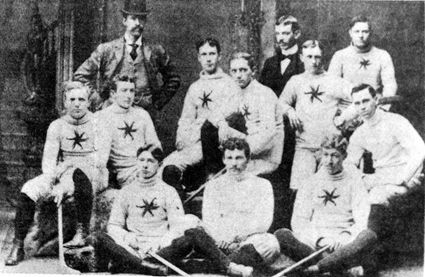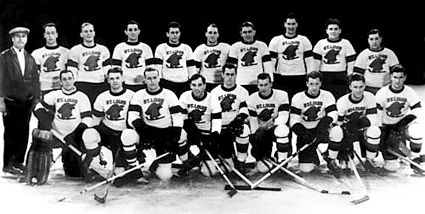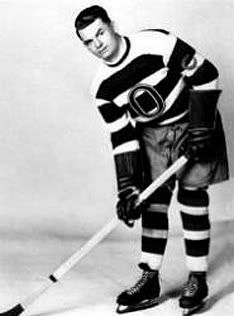The original Ottawa Senators were founded back in 1883 as an amateur club, later becoming a professional team. In the early years of hockey the club moved from league to league as the organization of early hockey was still finding it's feet.
Aside from the changes in leagues, the club also took some time to settle on a permanent nickname as well. Known as the Generals in the 1890's, the club was known as the Silver Seven from 1903 to 1907 before adopting the name Senators starting in 1912.
The 1885 Ottawa Hockey Club
One of the most successful teams in the early days of hockey, the club won the Stanley Cup in 1903, 1904, 1905, 1906, 1909, 1910 and again in 1911 during the cup's "challenge era".
The 1911 Ottawa Senators posing with their Stanley Cup
By then, the team had joined the National Hockey Association, which lasted from 1910 to 1917. After the NHA dissolved, the Ottawa Senators joined the brand new National Hockey League as a charter member in 1917. They soon rose to prominence, capturing four more Stanley Cups in 1920, 1921, 1923 and 1927.
The 1919-20 Ottawa Senators
After winning the championship in 1927, the Senators began a decline in fortunes, primarily due to the small size of Ottawa when compared to the other cities in the league at the time. Ottawa's population in 1931 was 110,000, one-fifth the size of Toronto, which was the second smallest NHL city at the time. They began to sell off their best players, suffered from low attendance at home against new expansion teams, such as the Boston Bruins, Chicago Blackhawks, Detroit Cougars, New York Americans, New York Rangers and Pittsburgh Pirates, and the higher travel costs to play those same teams all located in the United States.
The Great Depression also affected the team and caused the sale of even more players, including King Clancy to Toronto. Things got so bad that the team suspended operations for the 1931-32 season and returned to finish with the worst record in the league two years in a row in 1932-33 and 1933-34. Finally the owners of the franchise announced that it would not return to Ottawa for the 1934-35 season due to losses of over $60,000 since resuming play and that he would be relocating the team.
The franchise was then moved to St. Louis, the seventh largest city in the US at the time, for the 1934-35 season and was named the Eagles, which was inspired by the St. Louis-based Anheuser-Busch beer logo.
While attendance was good, the team fared little better financially in St. Louis however, with long, expensive train trips to New York and Boston as well as a large number of games against Montreal and Toronto, as the poor Eagles were forced to take Ottawa's place in the Canadian Division of the NHL, despite being located much closer to Chicago and Detroit of the American Division.
The 1934-35 St. Louis Eagles
The club finished with a dismal record of 11-31-6 for last in the league, while they again were forced to sell players, including team captain Syd Howe, who lead the team in goals despite being traded to Detroit late in the season to help meet expenses. Finally on this date in 1935 the owners of the franchise sold the club back to the NHL for $40,000 and the players were then sold off to the remaining eight clubs in the league.
It would be 32 years before the NHL would return to St. Louis when the Blues joined the league in 1967 and 58 years before the league would come back to Ottawa in 1992 with the new incarnation of the Senators.
Today's featured jersey is a 1934-35 St. Louis Eagles Frank Finnigan jersey worn by Finnigan during the St. Louis Eagles only season.
Finnigan was born in 1900 and played in the NHL from 1923 to 1937 for Ottawa, Toronto and St. Louis and was nicknamed the "Shawville Express".
He would win a Stanley Cup with Ottawa in 1927 and was team captain from 1930 to 1933, scoring a career high of 21 goals and 36 points in the 1929-30 season during 43 games played. He played in Toronto the season Ottawa suspended play, winning his second Stanley Cup with the Maple Leafs, and returned to Toronto after being one of the players sold by St. Louis in 1935. He also held the distinction of having played in the first NHL All-Star Game in 1934, which was held as a benefit for Toronto player Ace Bailey.
In 1989 Finnigan was part of the effort to bring back NHL hockey to Ottawa and made public appearances on behalf of the effort and was part of the presentation to the NHL expansion committee at the age of 90. He was scheduled to drop the puck at the first new Senators game in October of 1992, but passed away the previous December at the age of 91, the last surviving member of the 1927 Stanley Cup champions. Finnigan's son, Frank Jr., was chosen to drop the ceremonial first puck in his place.
On the night of the first game new Senators game, Finnigan's number 8 was retired by the club, still the only number retired by the team other than the league-wide retirement of Wayne Gretzky's #99.
In addition to having his jersey number retired, the street in front of the Senators arena, Scotiabank Place, was named Frank Finnigan Way in his honor.
Here is video from the first game of the new Ottawa Senators on October 8, 1992, including the opening of Hockey Night in Canada on that day and the first Senators goal of the new era.
Here is a brief recap of the original Senators history and how it influenced the branding of the newly reborn Senators.


















No comments:
Post a Comment
We welcome and encourage genuine comments and corrections from our readers. Please no spam. It will not be approved and never seen.